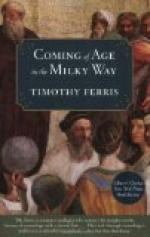
|
| Name: _________________________ | Period: ___________________ |
This test consists of 15 multiple choice questions and 5 short answer questions.
Multiple Choice Questions
1. In what country is Stonehenge located?
(a) France.
(b) England.
(c) Germany.
(d) India.
2. By the time of Archimedes' death, Greek science, along with the rest of the intellectual world, had been transferred from Athens to where?
(a) Rome.
(b) England.
(c) Sparta.
(d) Alexandria.
3. The last great Western scientist before the Dark Ages was whom, according to the author?
(a) Archimedes.
(b) Marco Polo.
(c) Ancius Boethius.
(d) Prince Henry the Navigator.
4. Giovanni Cassini studied data by what astronomer who observed Mars at its closest passage to earth and determined, a value of 87 million miles for the astronomical unit?
(a) Marco Polo.
(b) Plato.
(c) Jean Richer.
(d) John Harrison.
5. In what year did Bartholomeu Diaz round the Cape of Good Hope on the southern tip if Africa?
(a) 1616.
(b) 1455.
(c) 1598.
(d) 1488.
6. American Indians lost in the woods could find their way with the help of whom, according to the author in Chapter 3: "The Discovery of the Earth"?
(a) Sky Dancer.
(b) Sky Mother.
(c) Father Sky.
(d) Spirit Mother.
7. In early models of the universe, what stood at the center of the universe?
(a) God.
(b) Earth.
(c) The sun.
(d) The moon.
8. The Middle Ages encompassed the period from the 5th century to when?
(a) The 16th century.
(b) The 12th century.
(c) The 13th century.
(d) The 15th century.
9. Newton's first law expanded on the theory of inertia by asserting that an object stays in motion unless it is what?
(a) Magnetic.
(b) Affected by radiation.
(c) Disrupted by another force.
(d) Tilted toward negative energy.
10. Copernicus and Kepler measured the distances of the solar system which were expressed in what?
(a) Astronomical units.
(b) Bosons.
(c) Leptons.
(d) Particles.
11. According to the author in Chapter 7: "A Plumb Line to the Sun," some ships and their crews were lost at sea because it was difficult to establish what?
(a) Mass.
(b) Longitude.
(c) Area.
(d) Latitude.
12. What is the astronomical model in which the Earth and planets revolve around a stationary Sun at the center of the universe?
(a) The Tychonic system.
(b) Heliocentricism.
(c) Asceticism.
(d) Triangulation.
13. Eudoxus went on to establish his own observatory where?
(a) Alexandria.
(b) The Nile.
(c) Athens.
(d) China.
14. Aristotle declared that a body in rest tended to do what?
(a) Stay at rest.
(b) Dissipate.
(c) Grow moss.
(d) Start moving.
15. When was Claudius Ptolemy born?
(a) 476 A.D.
(b) 90 A.D.
(c) 120 B.C.
(d) 224 A.D.
Short Answer Questions
1. Aristotle created a model of the universe based on whose work?
2. What is the science of the measurement of time, or timekeeping?
3. Galileo was appointed as a professor of mathematics at what institution?
4. What foremost astronomer of the sixteenth century proved Aristotle wrong in 1577?
5. What is the discipline that deals with the nature of the Universe as a whole?
|
This section contains 445 words (approx. 2 pages at 300 words per page) |

|




